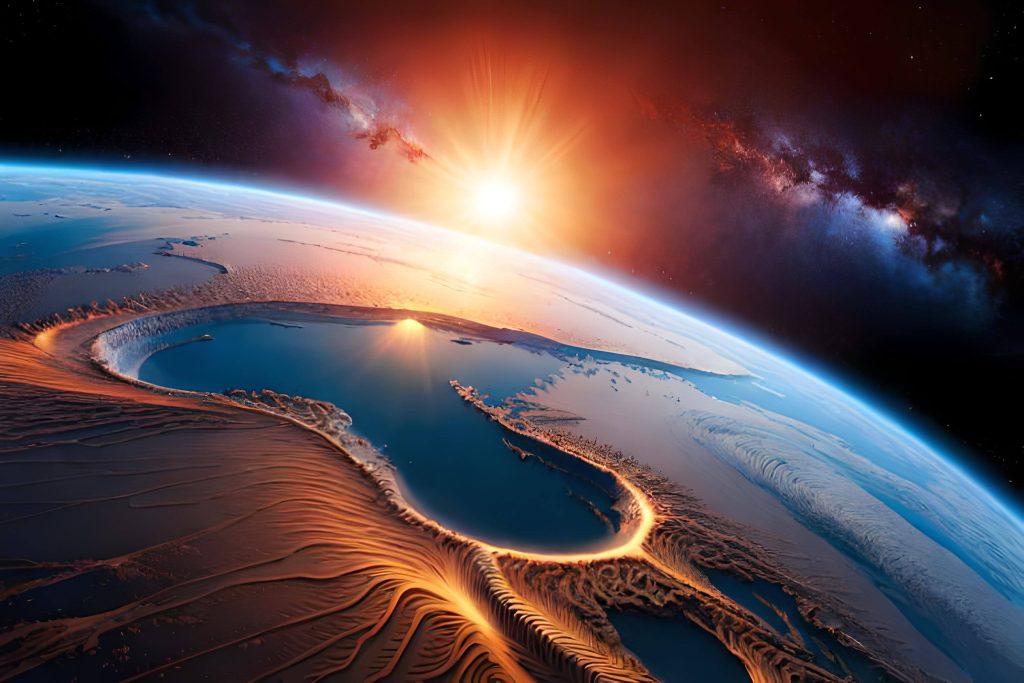How Do We Know Earth Age?
How do you know the entire age of a planet – by just analyzing a single atom?
We, everybody, know that our Earth is 4.5 Billion years old, But how?
How is this possible? Who was there around to see it formed?
OR why you should believe in this fact. Is this accurate or just an assumption? You are reading Babal Bulletin and here’s how we know the earth’s age.
Watch Video:
How Do We Know Age Of Earth Exactly?
Planet Earth is estimated to be 4.54 billion years old. It represents the earth’s accretion.
Accretion

In astrophysics, accretion is the process where particles accumulate by attracting more matter through gravitational forces. This process typically occurs in an accretion disk, which is a structure made up of gas and other particles. Most astronomical objects, including galaxies, stars, and planets, are formed by accretion processes.
Evidence
This is the oldest rock on Earth. It is named “Zircon Mineral”. which makes up some of the oldest rocks on earth, formed at least 4.404±0.008 billion years ago. Zircons are durable crystals that can survive erosion and be deposited in sedimentary or metamorphic rocks.
This mineral zircon is generally used for radiometric dating because it has a fairly large amount of uranium.
Scientific inquiry indicates that some minerals on Earth are at least 4.031 (4.031±0.003) billion years old
The earth is much older than the age of the oldest datable materials we have found so far.
Past Calculations

In 1779, Comte du Buffon made an experiment to find out how old the Earth is. He created a small globe with the same materials as Earth and measured how long it took to cool down. From this, he estimated that Earth was around 75,000 years old. (pum pum pum)
At the same time, Nicolas Steno observed the link between fossil remains and strata. He was the first naturalist to appreciate this connection. His observations led him to develop important stratigraphic concepts like the “law of superposition” and the “principle of original horizontality.
William Smith suggested in the 1790s that rock layers with similar fossils in different places are likely to be of the same age.
In the 18th century, a naturalist named Mikhail Lomonosov suggested that Earth was unique and separate from the rest of the universe, and had formed hundreds of thousands of years earlier. But this idea is not confirmed.
In 1830, Geologist Charles Lyell, influenced by James Hutton, introduced the concept that Earth’s features are in constant change. This contradicted the traditional view which saw Earth’s history as a series of catastrophic events. Lyell’s ideas led to the development of uniformitarianism, which states that changes on Earth are constant and uniform. Many naturalists became uniformitarians due to Lyell’s influence.
William Thomson calculated in 1862 that the age of the Earth was between 20 million and 400 million years, assuming it was a completely molten object that cooled over time. Geologists and biologists had trouble accepting such a short age for Earth.
In 1869, Thomas Huxley attacked Thomson’s calculations, suggesting they were based on faulty assumptions. Other scientists, such as Hermann von Helmholtz and Simon Newcomb, independently calculated similar ages to Thomson’s.

In 1895, John Perry challenged Thomson’s figure based on his assumptions on conductivity, and Oliver Heaviside joined the debate.
According to him, Earth’s age is 2-3 billion years using a model of a convective mantle and thin crust, but his work was ignored.
In 1899 and 1900, John Joly calculated the rate at which the oceans should have accumulated salt and determined that they were about 80 to 100 million years old.
Lord Kelvin calculated Earth’s age using thermal gradients and estimated it to be about 100 million years old. But he didn’t consider Earth’s mantle convection which invalidated his estimate.
George H. Darwin proposed that Earth and Moon had broken apart in their early days, which added additional evidence to Thomson’s calculations.
The discovery of radioactivity introduced a new factor in the calculation of Earth’s age. The discovery of radioactive elements, polonium and radium, and their heat production via radioactive decay led to the realization that Earth’s original heat was continually reloaded.
George Darwin and John Joly were the first to point out the implications of radioactive decay on Earth’s age calculations in 1903.
Modern Radiometric Dating

Later in 1905, Ernest Rutherford invented a method called “Radiometric Dating”. It was developed to measure the content of carbon. Today this method is used to examine rocks from the moon and meteorites.
Radioactive decay generates exotic elements over time in rocks containing radioactive isotopes. To figure out how old a rock is, scientists can measure how much of a certain element has decayed into a stable product. They use the half-life of the element and its original amount to calculate the rock’s age.
The discovery of radioactivity introduced another factor in the calculation and provided a basis for new calculations in the form of radiometric dating.
Ernest Rutherford and Frederick Soddy discovered that radioactivity happens when atoms of a radioactive element randomly change into another element, and this change happens at a unique speed for each type of radioactive element.
Radiometric dating is a way to figure out how old things are. Scientists have used over 40 methods to calculate the earth’s age to this date, and modern dating technique is considered the most accurate and effective for measuring geologic timescales.
The age of Earth is determined to be 4.5 (4.55 ± 0.07) billion years using uranium-lead isotope dating on meteorites including the Canyon Diablo meteorite.
Geological samples from Earth can’t give an exact date because of mixing and unmixing caused by plate tectonics, weathering, and hydrothermal circulation.
Dating rocks using isotopes can be messed up by processes like plate tectonics, weathering, and hydrothermal circulation. To make sure the date is accurate, scientists often date different minerals in the same rock or use more than one dating method.
Some meteorites are believed to be the original material from which the solar system was created, and they stayed isolated from outside influences after the formation of planets.
Very old rocks called galena have been used to figure out how old the Earth is. They showed that the Earth is around 4.54 billion years old.
Several meteorites that have undergone isochron dating have different age ranges based on different isotopic dating mechanisms.
Different methods of dating have been used on several meteorites, and they have given different age ranges.
Some meteorites are over 4.56 billion years old, and rocks from the moon and Mars are around 4.5 billion years old.
These dates are close to the time when the solar system started forming from gas and dust around the sun.
Knowing these relative ages helps to create a timeline of how Earth, the moon, Mars, and other rocks in space started forming.
An Earth and planetary scientist at Harvard University, Rebecca Fischer explained that the formation of planet Earth took place over millions of years.
Age Of Solar System
Formation of the earth is interlinked with the creation of our entire solar system. For that scientists use a rare type of meteorite called the Canyon Diablo meteorite to determine the age of the solar system.
This meteorite contains minerals that can be used to investigate isotopic dates. The age of the solar system is estimated to be 4.53 to 4.58 billion years old, which is supported by hundreds of other age determinations.
The Moon and Martian meteorites have also been used to determine age dates. Lunar samples are useful because they have not been disturbed by weathering or plate tectonics.
Scientists use different methods to confirm the age of the solar system, including direct electron microscope examination and cosmic ray dating.




